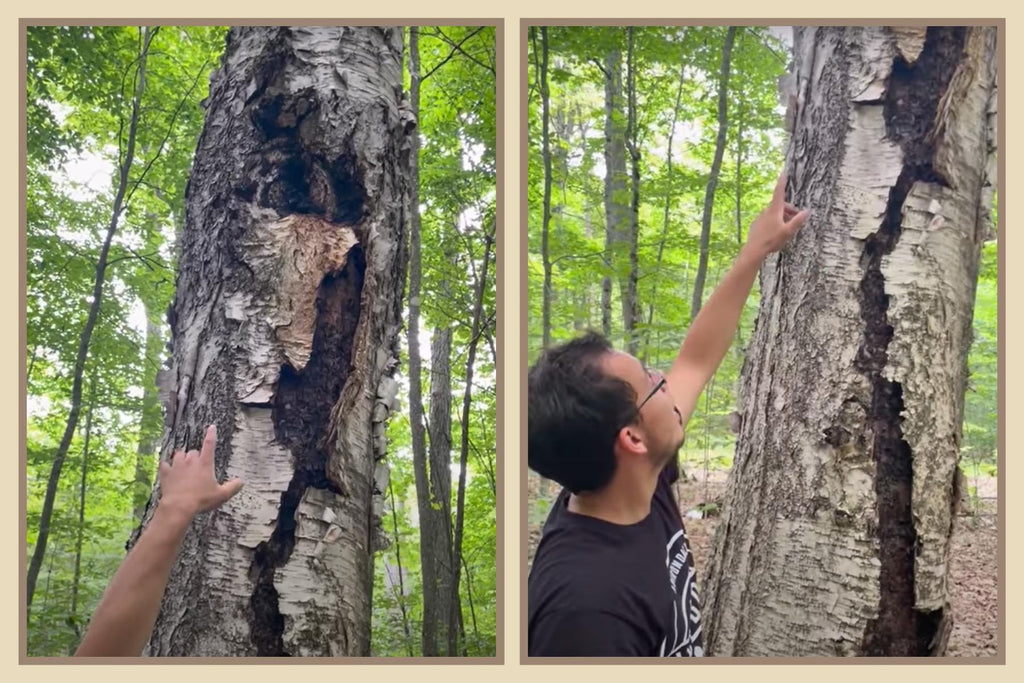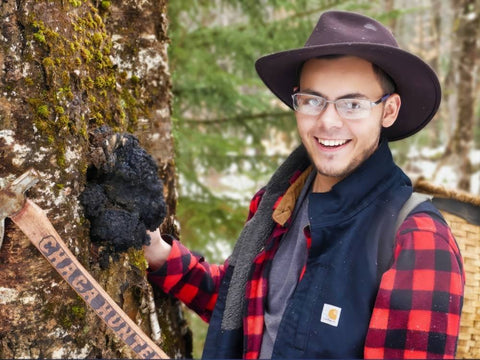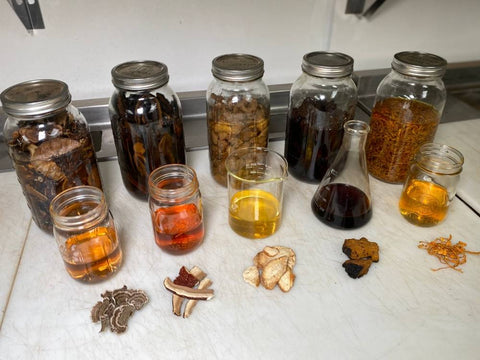After eight years working hands-on in the forest to source wild chaga, I have learned that chaga is one of the most misunderstood organisms on Earth. While there is vast information available on the internet covering chaga’s health benefits, the same cannot be said about information on chaga’s ecology and life cycle. That is the gap that I aim to bridge in this blog, as both topics are quite intertwined. Let's get right into it: Here are 10 of the most poignant misconceptions about chaga.
Misconception #1: Chaga is a Mushroom
The #1 misconception about Chaga is that people falsely understand it to be a mushroom. Despite the fact that almost every time you read the word ‘chaga’ online, it is followed by ‘mushroom,’ the truth is that Chaga is not a mushroom.
Let’s start by defining a mushroom. A mushroom is a fleshy, moistureful, spore-bearing fruit of a fungus. Mushrooms are reproductive organs produced by some fungi. Some fungal organisms produce tens, hundreds, even thousands of mushrooms throughout their lifetime. While all mushrooms come from fungi, not all fungi produce mushrooms.
Chaga, the part of Inonotus obliquus that we harvest and make tea out of, is a fungal organ known as a sclerotia (pronunciation: skler-osha). A sclerotia is a compacted mass of hyphae that works as a defensive control center for parasitic fungi. A sclerotia concentrates, synthesizes, and stores a plethora of immune mechanizing compounds in order to protect itself from living hosts. In the case of Chaga, that would be the birch tree. Chaga is fungal armor; a sclerotia that develops as a mechanism for Inonotus obliquus to defend against the birch tree's various attempts to attack and eliminate the parasitic fungus within.

Many people are familiar with sclerotia and don't even know it! See the image above for common sclerotia vs common mushrooms.
Ironically, this is exactly why Chaga is so good for us. Mammalian biology has ancient roots in the fungi kingdom. Animals split from from fungi some 1.538 billion years ago. Surprisingly, human DNA has much more in common with Chaga's DNA than meets the eye. Marvelously, many of the constituents that offer protection and health benefits to Inonotus obliquus can do the same for our human immune systems.
Misconception #2: If it's called Chaga, it is real Chaga.

A huge red flag is that there are mainstream chaga products on the market that use fake chaga grown on myceliated grain and brown rice flour! Take a look at the image below. This is a comparison between a Birch Boys chaga tincture and another brand's chaga Tincture. Notice the incredible difference in color. Clearly, something doesn't add up here.

While I won't name names, it is truly sad to me that this gimmicky chaga is being peddled by the same man who has become the face of the entire mushroom movement. The incredibly dark color of any real chaga Tincture can be attributed to the soluble melanin that exists in wild chaga. This is obviously present in a Birch Boys chaga tincture. Yet there a total absence of this valuable constituent in the chaga extracts sold by 'the leading brand'.
This one difference is easily discernible, but there are other less-obvious questions to be raised about artificial chaga. Another valuable component of chaga is betulin, which is directly absorbed and inherited from the bark of birch trees.
We are reluctant to call this true fraud, but that's certainly what it feels like. It is difficult to respect individuals who make products from this and market them as "chaga" extracts for connotative health benefits when said individuals know very well - it is not the same thing.
Read more about fruiting body vs mycelium
On a lighter note:

If you’ve tried chaga that didn't taste very good from a woodsy friend or some random supplier, give Birch Boys chaga a try before you write chaga off. There are a lot of well-intended novice chaga harvesters who (after picking their first piece of chaga) excitedly urge friends and family to drink it.
If it "tasted like dirt", it may be that it was picked from a dead or fallen tree. chaga dies shortly after the collapse of its host, so it is important for harvesters to recognize that some of the chaga in the forest has already "gone bad". chaga should always come from a living, standing birch tree. Quality chaga will be less crumbly, more vibrant, better-for-you, and pleasant-tasting.
Misconception #3: Chaga has a Symbiotic Relationship with the Birch Tree
The notion that chaga and birch trees have a symbiotic relationship makes for a great story. But this is simply not true. There is no evidence to suggest that chaga is anything other than a parasite to birch trees. Any northern hunter, logger, or outdoors-person could tell you that. But it's not hard to see for yourself!

At the end of chaga’s life cycle, it rips open a vertical section of its host's trunk to reveal its reproductive poroid. In the vast majority of cases, this results in the death of the tree.
The scientific name of chaga's genus, Inonotus, literally means “to penetrate.” Chaga's life begins when a microscopic chaga spore penetrates the bark of its host tree. From there, as long as the temperature is above freezing, it slowly colonizes its host until it takes over a large section of the tree's internal heartwood. Finally, in a sort of murder-suicide, it reveals its flaky porous face to spread spores of its own.
There was a study done by a mycologist in Finland who estimated that between 6%-30% of all birch trees are killed by chaga.
Misconception #4: Chaga Only Grows on Birch Trees

While it is definitely true that chaga grows primarily on the birch tree, chaga also grows on a variety of different tree species. It has been found on:
- Maple
- Poplar,
- Elm
- Cherry
- Hop hornbeam (ironwood),
Plus various species within the Betula (birch) family.
While chaga found on other trees may have value, a number of birch-specific compounds are an important part of chaga’s researched benefits. We only harvest chaga from birch trees. I would advise against consuming wild edibles that you are not 100% certain about.
Chaga also has a look-alike. It can be easily confused with Phellinus igniarius.

Misconception #5: Chaga is not as Good for the Immune System as Other Fungi
There is a common misconception that chaga isn’t as good for the immune system as some mushrooms (such as reishi or turkey tail), due to the fact that these mushrooms have a higher concentration of beta glucan. I view this as an inaccurate and simplistic way of looking at chaga.
While It is true that in typical mushrooms, beta glucan is a key micro-nutrient with proven immune-supporting properties, we must consider the plethora of other immune-supporting compounds found in chaga. The chemistry going on in chaga is very complex.
The global scientific community is still in the very beginning stages of understanding and classifying the powerful compounds found in chaga.
A few of these notable compounds that are highly interesting to medical researchers include inotodiol, trametenolic acid, betulin and betulinic acid, fungal melanins, polyphenols, ergosterol peroxide, gallic acid, ergothioneine, and more. The aforementioned compounds are ALL compounds with immune supporting properties. A simple google search on these compounds will result in a variety of literature on these compounds' ability to modulate and support immune function in mammals and/or in vitro.
This literature makes it clear that when we are talking specifically about chaga, beta glucan is rather basic in the grand scheme of things. The other "other" compounds seem to have a superior capacity for powerful immune support. Immune support score charts based on beta-glucan alone is a symptom of the fact that beta-glucan quantification tests are readily available from third party labs and accredited analysis service providers. The same cannot be said about many of the others. It is not currently easy to quantify the array of immune supporting compounds in chaga.
I would be skeptical about purchasing chaga products from a mushroom brand that doesn’t understand, or doesn’t take into account, chaga’s specialized life cycle and uniquely complex myco-chemistry.
Misconception #6: Chaga Takes 10+ Years to Grow
It is commonly said that chaga takes an extremely long time, up to 10 years, to grow to full maturity and produce spores. This is not necessarily true. We’ve already discussed that chaga consumes the heartwood of a tree before producing a reproductive poroid - but it's worth stating that the time it takes for the chaga to conduct this process is relative to the size and age of the birch tree it inhabits.

The piece of chaga in this image could easily have been missed due to it’s small size. I’d estimate that this conk of chaga is about 1-2 years old. This tiny tree also sports a chaga poroid. In young and skinny trees, chaga is able to fully mature, develop its sclerotia and produce its reproductive structure in a couple years. We see this often as chaga makes its way into younger forests that have been logged within the past 10-20 years.

Misconception #7: Otzi The Iceman Carried Chaga
Otzi the iceman was a nomad who lived during the copper age. He was found in the European Alps in 1991, preserved in the ice for 5000 years. Otzi equipped a pouch, full of a variety of tools and items. The myth is that he was found carrying a piece of chaga, with an accompanying theory that he used it as a fire-starter. While it is true that there is indigenous history of using chaga as a fire-starter, Otzi was actually carrying hoof polypore, Fomes fomentarius, also called “tinder fungus.”

This misconception is completely understandable when you take into account that chaga, hoof polypore, both possess the ability to hold an ember. I thought this would be a great opportunity, not only to explain the misconception, but also to demonstrate chaga’s tinder-like properties.

Chaga will burn for an extremely long period of time without going out. Chaga will never burst into flame, but once an ember gets started, it simply won’t go out without a fight. I learned this for the first time myself way back when I used to dry chaga in an oven. I had only set the oven to 180 degrees (Fahrenheit) and had a big pan of ground chaga drying within. I’m not sure exactly what happened, but somehow a spark had formed, I smelled the smoke, and the chaga was smoldering.
I tried to save and separate the chaga that was burning from the unaffected chaga but it turned into a total disaster that inevitably required a sprint to the tub and several gallons of water to extinguish. If you ever do use chaga as an incense or a fire-starter, remember that it can be dangerous. Unless submerged completely underwater for a length of serious time, it may reignite.
Misconception #8: Chaga Has No History Of Indigenous Use In The U.S.
It’s commonly said that all of the indigenous usage of chaga occurred exclusively in Russia/Siberia, or that the indigenous peoples of the Americas did not use chaga. This isn’t a topic that is well-documented or easily found online. The devastating reason for that is the intentional destruction of indigenous knowledge, culture, and history that occurred during the colonization era. This was an atrocity.

I have been incredibly fortunate to learn from a number of customers of mine who are members of the Haudenosaunee (ho-den-o-sho-nee) people or Six Nations (the name given to them by the English was ‘Iroquois’), whose peoples occupied much of what is now Northern New York, the Great Lakes region, and Ontario. The word Haudenosaunee means ‘people of the longhouse.'
They built the walls, siding, and roofs of these longhouses with strong panels of bark from the yellow birch tree (Betula alleghaniensis). Softer white birch trees were also used to make canoes.
The Haudenosaunee used chaga as a natural medicine, but they also used chaga as an additive to enhance smoking tobacco. Chaga's ember-retaining properties enables for a longer-lasting tobacco smoking experience.
Tobacco is considered a sacred medicine in the Haudenosaunee culture. It was often left as a gift of reciprocity at the base of birch trees during a chaga harvest. There is indeed much historical indigenous use of chaga in the U.S., but unfortunately much of it may remain largely unknown.
Misconception #9: Chaga is Snake Oil/Chaga Doesn’t Work
Since there's so much hype about chaga’s benefits, and we’ve still heard nothing about it from western medicine, chaga must not work, right? Wrong. I want to elaborate on this and explain the important distinction between something like chaga (an herb or natural remedy) and a prescription drug.
A natural substance, fungus or herb is going to be rich in a number of different compounds - and these compounds, whether healing or not, will be present in differing concentrations from one specimen to the next.

In contrast, the world of pharmaceuticals is vastly different. With pharmaceuticals, a compound or micro-nutrient is isolated and concentrated to meet a specific dosage. These compounds and micro-nutrients often are directly or indirectly derived from nature. After the compound is isolated and concentrated the process will then move onto clinical trials which test on hundreds to thousands of people of varying demographics. Only after a clinical trial is completed will an isolated compound become a medication.
Now, it would be great if there were a clinical trial on chaga as a whole, but it’s incredibly unlikely that will ever happen. A clinical trial costs millions of dollars to sponsor. It is much more likely that an established pharmaceutical company will focus on a specific component such as betulin, inotodiol, trametenolic acid, etc., and try to find a way to synthesize that same compound in a lab-setting. That way, the company can patent the process to produce a medication and build a business plan around it.. That’s just the way western medicine works.
Good old big pharma and independent researchers alike are indeed looking at the constituents in chaga, and they are attempting to find a way to synthesize those constituents in a way where they can establish price-protected intellectual property.
I believe that some of these constituents will indeed become patented medications, but you will never be prescribed chaga tinctures or chaga tea from a licensed physician. There is, however, very real potential that future medications will be discoveredthanks to chaga.
Misconception #10: Chaga Harvesters Threaten Chaga’s Sustainability

Last, but certainly not least, is the misconception that chaga harvesters are a leading threat to wild chaga’s sustainability. This is not true. If there are any clear and present dangers to wild Chaga, it would have to be logging and deforestation. Forested land is assessed based on the value of its timber. And for this reason, chaga is painted in a very negative light throughout much of the logging industry.

In fact, numerous logging companies have sustainable forest management plans that include targeted killing of all birch trees that show signs of chaga growth. The traditional field of forestry perceives chaga as a parasitic threat to timber value. For many years, long before chaga's rise in the spheres of health food / functional supplements, chaga has been treated as an unhealthy disease to the forest.
One of our independent harvesters started selling me chaga because it was a part of her work duties to cut down chaga-infected birch trees. Prior to bringing it to us, that chaga was just being thrown away. I cannot tell you how many stories I’ve heard from locals about hundreds of pounds of chaga being thrown away like garbage at the mill.
I've heard chaga called - please excuse my language - “horse cock” because it ruins the interior wood of the tree. It’s an unfortunate reality, but a reality nonetheless. That said, it seems to me that change is on the horizon. All of a sudden, the timber industry and land management companies are becoming more open to the idea that there exists value in nature beyond timber. People in high places are starting to become more receptive to permaculture principles. Not only because it is the right thing to do - but because it may also offer a more lucrative future model of doing business in the woods going forward.
If we look forward to the future of chaga's sustainability, I feel it is imperative that wild chaga becomes embraced and accepted as a valuable wild crop in northern forests. My opinion is that there exists a triangle of interdependence between birch trees, chaga, and people. Good forest management is what it is all about, and it will be advocacy for the protection and natural regeneration of conducive chaga habitat, led by chaga harvesters, that will secure a sustainable future for wild chaga.
And yes, there will be those who grow fake chaga on false substrates urging that wild chaga harvesters are the bad guys. Make no mistake that such people are just greasing the wheels for a world where we no longer recognize the value of nature. We can't make chaga better than Mother Nature can. Treating wild chaga as if it’s irrelevant or unimportant may be the only lethal threat for wild chaga.

If you’re in an urban or suburban area, you’re likely not going to find any chaga. This is not due to some irresponsible harvester stealing all of the chaga from these areas. It’s because there’s no trees there that support chaga. There’s no old growth stands of yellow birch, because we cut them all down long ago.
Anywhere that we’re cutting down forests to make farmland, cities, highways, parking lots, or developments, impacts an inconceivable number of species that were once found there. That is the biggest threat to chaga - and all of the other relevant organisms that are in danger, whose habitats humanity has eradicated en masse.
Fungi-enthusiasts need to embrace wild chaga and wild chaga harvesters need to abide by a fact-driven code of ethics informed by chaga’s life cycle. The scope spans far beyond the chaga harvester. It’s even bigger than the timber industry. It’s the bugs, spiders, animals and plants. It’s about nature, ecology and the natural path. We humans need to change our ways on a large scale. Without that, every single species is threatened, including chaga.

We covered a lot of information here today, I hope that you found it valuable and educational.
About The Author
Garrett Kopp is the 25 year old Chaga visionary and founder of Birch Boys, Inc., a company well-known for its assortment of teas, tinctures, and extracts from healing wild fungi. Kopp grew up in the Adirondack Mountains, where he naturally developed a broad passion for the wild northern forests of New York. He began to specialize and narrow this passion toward Chaga after a freak accident where he helped himself to a cup of what appeared to be iced tea in his Grandmother’s refrigerator, who had started harvesting Chaga and brewing it on her own amidst a battle with stage 4 pancreatic cancer. Soon thereafter, Kopp and his grandmother expanded their Chaga harvesting activities to local farmer's markets, where they discovered significant demand for the fungus and its powerful ability to help everyday people.
These entrepreneurial efforts landed Kopp acceptance into Clarkson University’s early entrance program, the Clarkson School, where he studied Engineering & Management and Innovation & Entrepreneurship. Several years and hundreds of research hours later, Kopp returned to his hometown. Having shipped to over 20,0000 individuals throughout all 50 states, Birch Boys has organically grown into a nationally recognized online brand . Kopp is proud to have built a vertically integrated supply chain, sustainably sourcing the fruits of tree-borne fungi from over 220,000 leased acres of leased private land in the Adirondack park, where it is carefully harvested by hand before being dried, processed, and extracted with love, at his fungi factory in none other than Tupper Lake, NY.
References
The global fungal red list initiative. (n.d.). Retrieved January 20, 2023, from http://iucn.ekoo.se/en/iucn/welcome







Comments (0)
There are no comments for this article. Be the first one to leave a message!